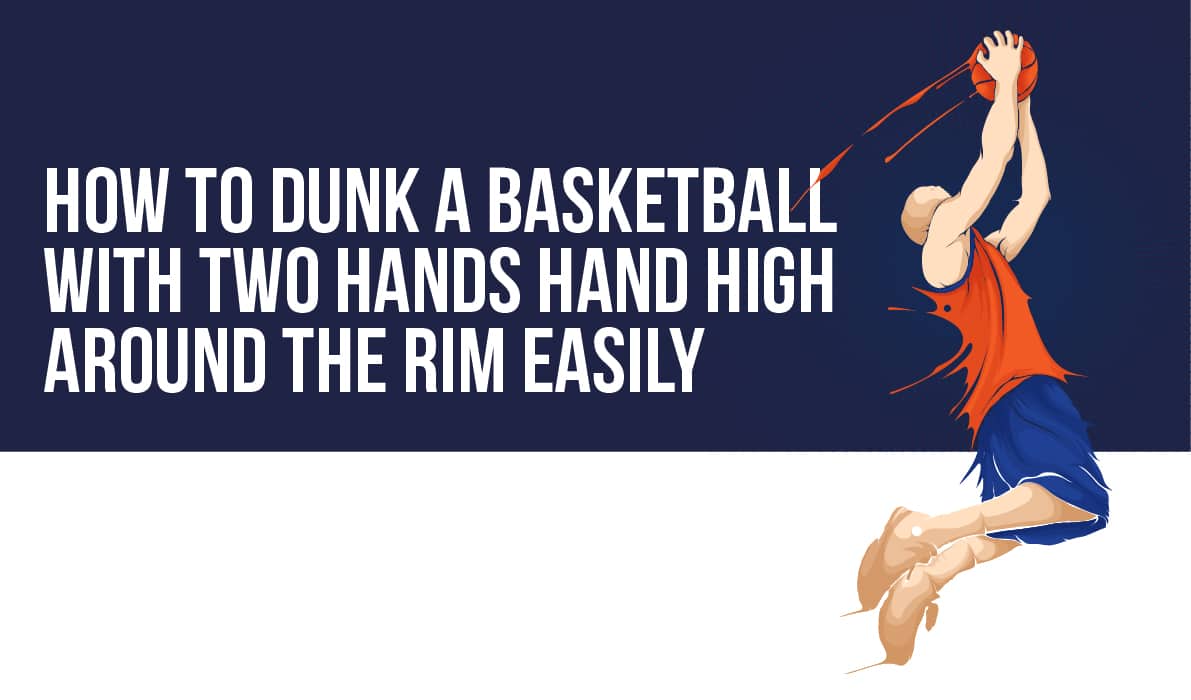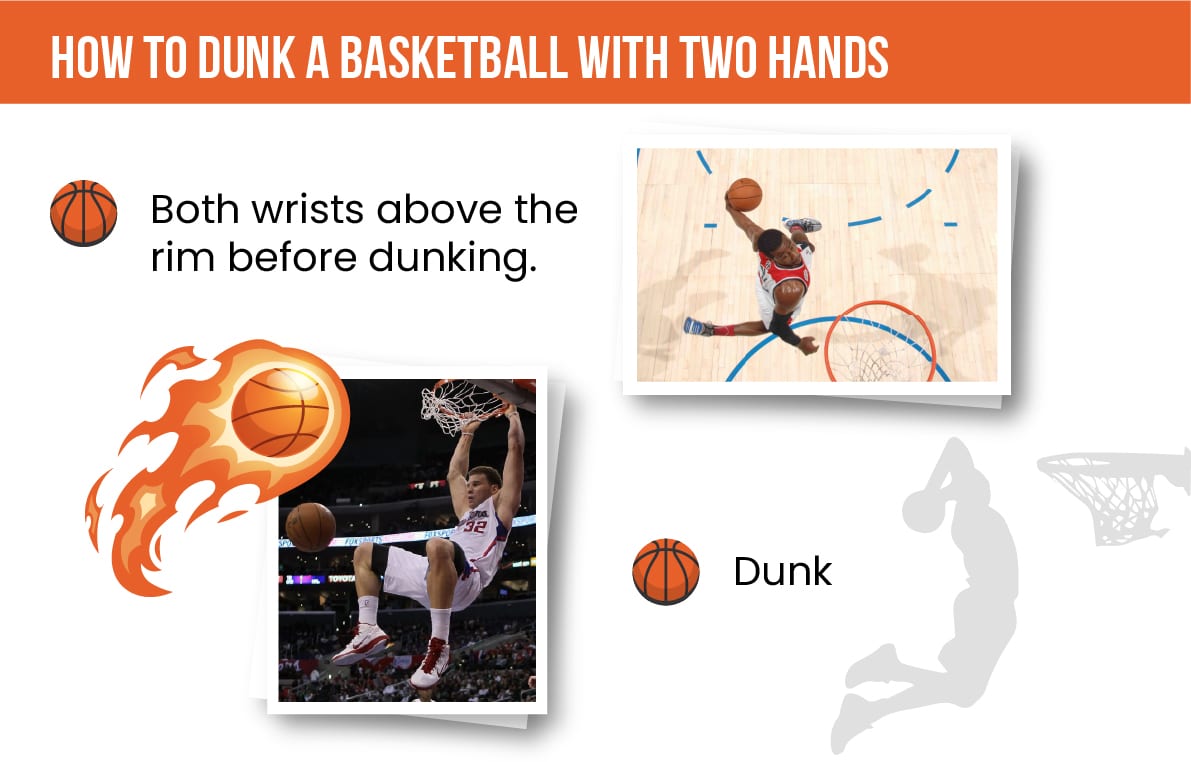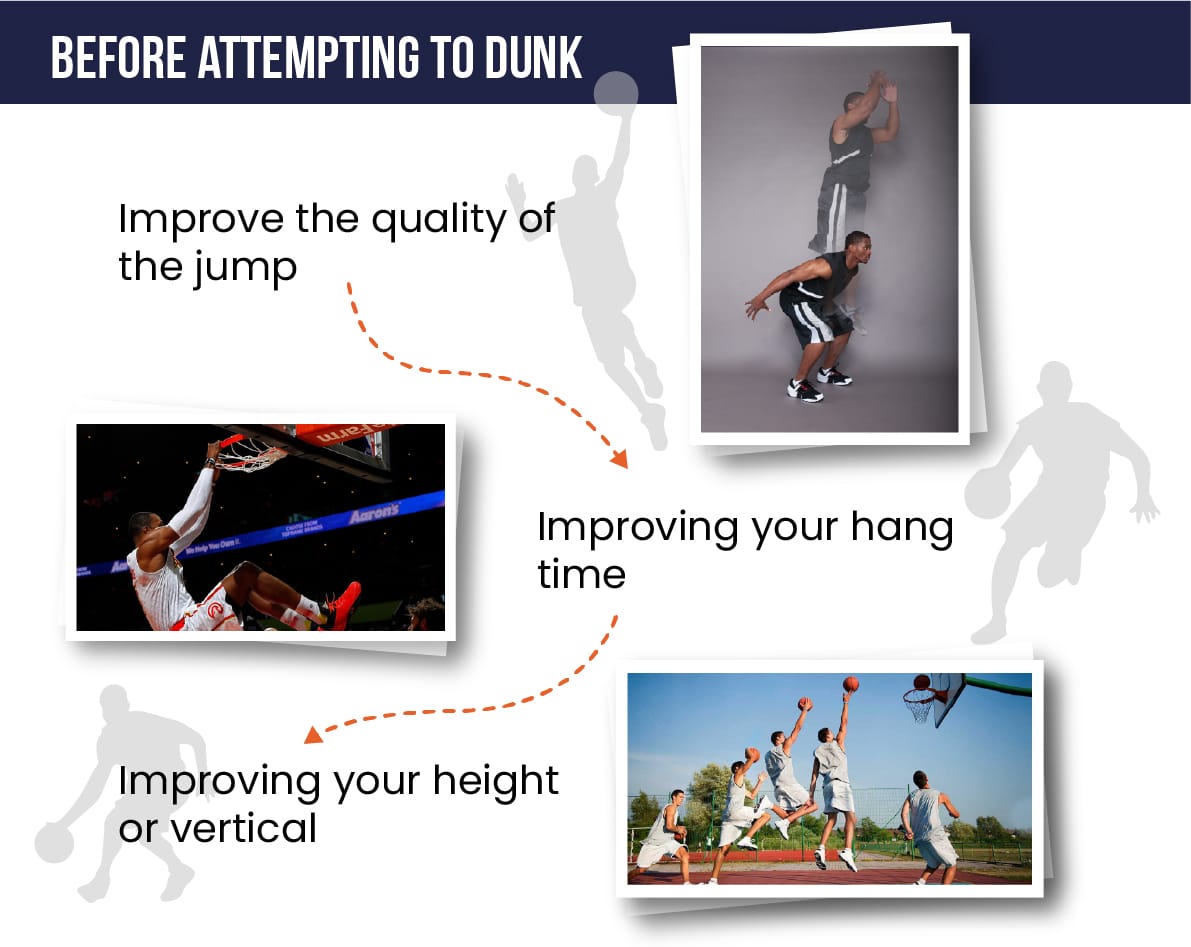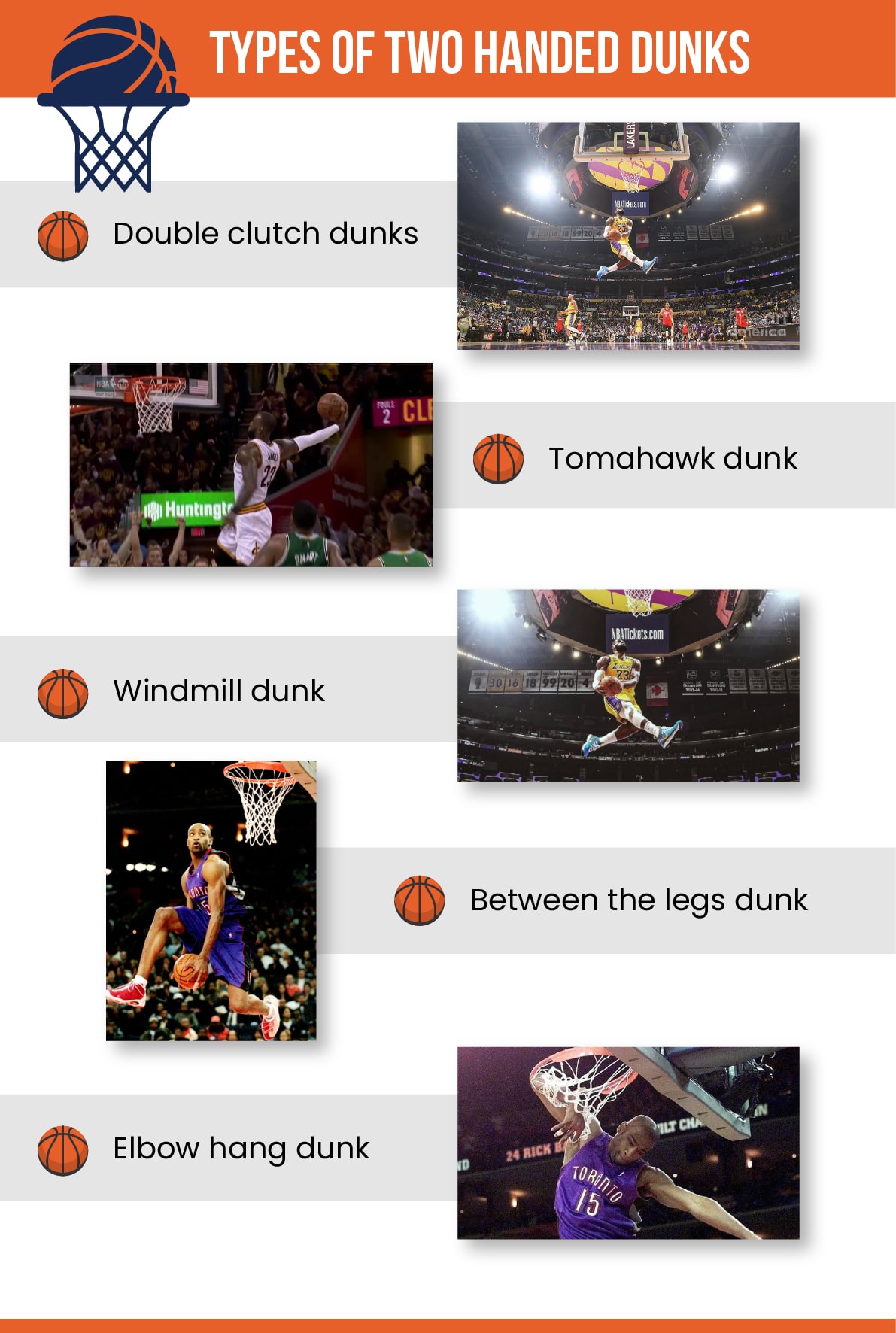
More often than not, people who dunk a basketball with two hands will not only hold the rim of the hoop afterwards but they also tend to hang onto that rim for a few additional seconds. In a previous blog, we dismissed this sort of thing as nothing short of showboating.
However, if you ignore the part where players hang onto the rim for added effect, you will actually find that there are indeed some merits to dunking a basketball with two hands. Chief among those, perhaps, is that dunking with two hands is the easiest way to progress when learning How To Dunk.
In fact, most Dunk Workouts available online - whether you find them in video or text - will feature a significant number of practice routines that leave you no other option but to dunk the basketball with two hands.
How To Dunk A Basketball With Two Hands?

If you harbour aspirations of dunking a basketball with two hands, you need to ensure that both of your wrists are above the rim before you complete the dunk. Having one wrist above the rim and the other below the rim just before you release the basketball simply isn’t going to cut the mustard.
Firstly, you are not going to make the all-important basket - which is a letdown for you and the team.
Secondly, you will increase the prospects of sustaining a serious injury to either the wrist or your entire forearm...or both. Without two wrists above the rim while trying to dunk the basketball with two hands, your body mechanics will not allow you to achieve any of the desired outcomes.
This is in stark contrast to what we suggested for Dunking A Basketball With One Hand. You might recall that the minimum requirement for dunking a basketball with one hand was about half a hand above the rim.

When dunking a basketball with two hands, you will likely struggle with reach, so there will also need to be an improvement to the quality of your jump - hang time and height matter a tremendous amount here - before you consider this in a competitive environment.
Is It Harder To Dunk With Two Hands?
Certainly in our mind - and some people might disagree on this - dunking with two hands brings with it some reach and height limitations, especially for shorter players and for beginners.
The irony here is that dunking with two hands is also probably the easiest way to learn how to dunk a basketball - for players who fall into that very same bracket.
Without dragging you in circles for too much longer, the short answer to your question is NO. It is actually easier to dunk a basketball with two hands.
However, the saga does not end there. When you dunk a basketball with two hands, you might find that it is also easier to master the complicated art of reverse dunking - which the professionals on the NBA execute with remarkable ease.
For the record, some of the best looking reverse dunks are completed when a player Jumps Higher Off Two Feet. There will be more on that another time though.
Another compelling method with which to dunk a basketball is something called the Alley-Oop Dunk. It is also without doubt one of the most fascinating moves in basketball. The players love pulling it off and feed off the energy that comes from spectators when they voice their approval for this glamorous dunk.
For those who might not know, a key component of the Alley-Oop dunk is the pass from a supporting player. Because we are all human, that final pass before the dunk is not always perfect, which means that you the dunker often have to make some form of adjustment before finishing that move off.
The margin for error when completing the Alley-Oop dunk is also significantly expanded or increased when you opt to dunk the basketball with two hands, instead of just the one.
When you dunk the basketball with two hands, you minimise your insecurities as somebody who is comparatively new to the game and you also absorb contact with greater ease when dunking a basketball with two hands. It is also easier to catch a basketball mid-flight when using two hands instead of one.
So, while we do not think it better or more rewarding to dunk the basketball with two hands, we definitely think using two hands makes it considerably easier to pull off some of basketball’s more complicated and glamorous moves.
When it comes to basketball - or any professional sport for that matter - we value efficiency over glam but we cannot hold anybody back, when they seek more enjoyment out of the sport. Often, what you seek out of the sport will determine whether you dunk the basketball with two hands or not.
Do You Dunk Using Two Hands Or One Hand?
The slam dunk can be executed with one hand or with two hands. Ultimately, you are the only person who can make that decision - whether that be on the practise court or in a competitive environment.
The decision you make on whether to dunk the basketball with one hand or two hands hinges on both your comfort level and the type of dunk that you are trying to execute. Throughout these pages we will tap on the various types of Slam Dunk with varying degrees of detail.

Of greater concern to us in this blog, though, will be the type of dunk that you use and whether it will be more appropriate to dunk with one hand or two hands when executing that slam dunk.
That should help you with your decision-making process.
1- Double Clutch Dunk
You can view clips for some of the most compelling Double Clutch Dunks here...in case you have not seen them before. As the name of this slam dunk would suggest, using two hands to dunk is the key ingredient here.
Towards the beginning of this routine, when you are about to Jump Higher To Dunk, you will have the option of controlling the ball with either the one hand or with both of your hands.We will mention many times in these pages that one of the most crippling fears when preparing to dunk centres on losing control of the basketball when you are airborne. So, on that score the convention when trying to execute the Double Clutch Dunk is to then bring the ball to chest level when you are airborne. Subsequent to this you will then drop your arms until the basketball is below waist level.
At this juncture your arms will be fully extended after completing what would essentially have been a thrust action. So, this is all very quick and basically second nature...the margin for error is already minimal.
From waist level, you will then pull the basketball to above head height and prepare to finish the move or the dunk. The thing to note is that there is a considerable amount going on here and it is all happening quickly.
Under those circumstances we would put it to you that the best way to go about your dunking business is to use two hands, although it is also quite possible to pull this type of dunk off by using one hand.
While there is always tremendous emphasis placed on Jumping Higher In Basketball, we will always tell you that the quality of the jump is more important. That is to say, the quality of your hang-time - which is normally a demonstration of your athletic ability as a basketball player.
That very athletic ability is critical with the Double Clutch Dunk, where the routine is often performed with a player’s back facing the basket or rim.
Once the ball is dunked, basketball players will then often hold onto the rim for additional special effect and admittedly some safety. The cameras and the spectators love it but the risk level is invariably higher. If you are going to try this dunk...again, we say two hands are better than one.
2- Tomahawk Dunk
For a few compelling visuals on the Tomahawk Dunk, you can click here. If you already know what a Tomahawk looks like, then you can easily guess what this type of dunk looks like when executed at its best.
Performed with one hand, the Tomahawk Dunk is truly something to behold. If you are going to pull this dunk type off, you should probably also learn a bit more on How To Jump Higher.When the Tomahawk Dunk is at its most glamorous it is performed with one hand but the dunk can also be executed with two hands and look just as efficient.
When you use two hands to perform the Tomahawk Dunk the commentators and fans will commonly refer to it as a “backscratcher”, which merely highlights the level of athleticism required to pull this off.
For the Tomahawk your arm will always be fully extended and above your head while you are airborne. Not only is the arm above the head but it is usually behind the head two. Holding on to the basketball can prove a tricky business.
The keywords that will always creep up in discussions about dunking a basketball with two hands are “ball security” and those words are particularly relevant with the Tomahawk Dunk.
If you want the cameras and fans to take note, by all means perform this dunk with one hand. If you aren’t too sure of yourself just yet, then stick to dunking with two hands here.
3- Windmill Dunk
By its very nature, the Windmill Dunk is easiest to perform when executing it with one hand.
However, the Windmill Dunk can also be executed with two hands. The key element with this dunk is the windmill motion of the arm when you are airborne and preparing to dunk.
It is a little tricky to pull that windmill motion off with two hands, as the body mechanics of it are a little complicated but doing the windmill with two hands is certainly not impossible.
Sometimes you can try doing the windmill motion with two hands and complete the dunk with just the one hand or vice versa - in case you are terrified by the prospect of losing that basketball before draining it in the hoop.
4- Between The Legs Dunk
Now we are really pushing the boundaries of dunking in basketball. Here is a glimpse of just how beautiful this type of dunk is when executed. You will often see this dunk executed with one hand by the best in the business but for ball security reasons, the desire to do this with two hands is valid.
When you put the basketball between your two legs (for no real reason really) you have to pass it from one hand to the other, so in that respect you are always going to be using both of your hands anyway.
However, it is the subsequent dunk that can be completed with either the one hand or with two hands. This is probably the one time that the author of this blog will actually opt for the dunk with one hand instead...no questions asked.
5- Elbow Hang Dunk
The only word that comes to mind when reviewing the Elbow Hang Dunk is “ostentatious”.
When it comes to showing off on a basketball court, this one is the top of the pack. To execute the Elbow Hang Dunk, you will approach the hoop as you would for any conventional slam dunk.
For that reason you can dunk the ball with either one hand or with both hands - the ball is quite literally in your court here. Once you have completed the dunk and the ball has drained through the hoop, instead of holding onto the rim with your hand or with your hands, you then slide your forearm into the hoop.
It will look and feel like your hand is following the basketball down the hoop or even like you are trying to retrieve it. You then hook onto the rim of the hoop with your elbow pit and hang there for a few seconds, while spectators just sit there and gawk.
Those who are familiar with this dunk have attributed numerous names to it. Among the more interesting ones are “honey dip”, “cookie jar” and “elbow hook” - all of them equally unnecessary but still as amusing and entertaining as the dunk itself.
How Can I Dunk Without Hurting My Two Hands?
We have actually touched on this topic before. There is an obsession out there about hanging onto the rim in basketball, when there actually isn’t any real need to do so. You do not get any additional points for holding onto the rim when dunking. That is the first thing that needs to sink in but our concerns actually extend well beyond that.
We advise against holding onto the rim when dunking a basketball because it can be a counter-productive exercise. If you hold onto the rim too long it can snap back and pop the ball out again before it drains down the net. That way you are just letting your team down.
In addition to that, referees do not view hanging onto the rim for extended periods in a good light and they are not shy about dishing out technical fouls for this. Again, you are essentially letting your team down for no good reason.
However, our final concern about hanging onto the rim when dunking centres on the damage that you are actually doing to yourself by doing it. Yes, basketball is a contact sport but some of your worst injuries can be self-inflicted because you have obsessed about hanging onto the rim when it dunking.
Initially, your hands will just hurt from holding onto the rim when dunking and maybe that is fine.
What is not fine is when you start tearing off pieces of your skin when holding onto the rim when dunking. That ripping off of the skin often comes about because you have not really mastered the intricate art of dunking in the first place. So, when you dunk “badly” you will hurt your hands. Dunking well will leave you much better off though.
Is Dunking With Two Hands Dangerous?
To the contrary, dunking with two hands is not only easier than dunking with one hand but it is safer than dunking with one.
It is not only safer from a “ball security” point of view (where you want to have better control of the basketball while you are airborne) but it is also safer because your body is likely to be better coordinated when dunking with two hands, than it will be when dunking with one. That means your landing after the dunk should be completed with fewer complications.
Conclusion
When considering whether you should dunk a basketball with two hands or not, learning to Jump Higher Off One Foot might come into the equation at some point. That certainly helps but much of the process actually hinges on what goes on in your mind.
Basketball players who are risk averse, like beginners and short players, will most likely adhere to dunking a basketball with two hands and they are also the ones most likely to dunk taking off from two feet instead of the one.
In basketball terms, things that come in two might present some limitations to what you can do on the court but they can also help ensure that you master the basics before moving onto bigger and better things.
Hey, I’m Aleksandar and I am a Basketball freak! That is why I decided to create this blog. Teaching people How to dunk a basketball and How to Jump Higher in this sport or other related sports that require vertical jumping, is my specialty. If that’s your aim, then you have come to the right place.
